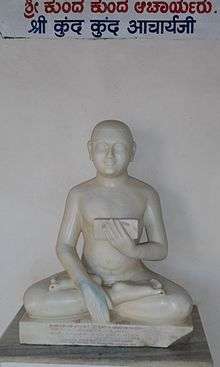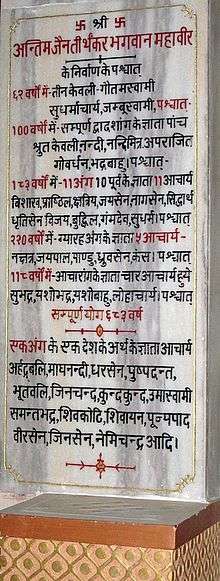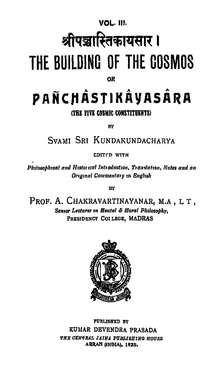Kundakunda
Kundakunda was a Digambara Jain monk and philosopher, who likely lived in the 2nd CE century CE or later.[2][3][4]
Kundakunda | |
|---|---|
 Idol of KundaKunda, Karnataka | |
| Personal | |
| Born | 2nd century CE[1] |
| Religion | Jainism |
| Sect | Digambara |
| Part of a series on |
| Jainism |
|---|
 |
|
Jain prayers |
|
Ethics |
|
Major sects |
|
Texts |
|
Festivals
|
|
|
He authored many Jain texts such as: Samayasara, Niyamasara, Pancastikayasara, Pravachanasara, Astapahuda and Barasanuvekkha. He occupies the highest place in the tradition of the Digambara Jain acharyas. All Digambara Jains say his name before starting to read the scripture. He spent most of his time at Ponnur Hills, Tamil Nadu and later part of life at Kundadri, Shimoga, Karnataka,[5]
Names
His proper name was Padmanandin,[6] he is popularly referred to as Kundakunda possibly because the modern village of Kondakunde in Anantapur district of Andhra Pradesh might represent his native home.[3][7] He is also presumed to be the one being alluded to by names such as Elacarya, Vakragriva, Grdhrapiccha or Mahamati, but these names have caused confusion and are likely incorrect because they have been used for other Jain scholars such as Umaswati in texts and others in inscriptions.[6]
Biography

Kundakunda belonged to the Digambara sect. Natubhai Shah places him in the second-century CE.[3] Jayandra Soni places him in either the 2nd– or 3rd–century CE.[2] Western scholars, however, place him much later primarily because of ideas he refers to and because his hagiography and quotations from his influential and important work begin to appear around 8th-century CE. For example, Paul Dundas dates him to about mid-8th-century.[8][9]
In the Digambara tradition, Kundakunda's texts are among the most important and treasured. The reverence for his scholarship is such that some later texts such as Pravachanasara list him third in importance, right after Mahavira and Mahavira's disciple Indrabhuti Gautama.[10] A.N. Upadhye in his critical edition of the Pravachansara suggests Kundakunda to have lived in the middle of the 2nd century CE.[11]
Thought
In texts such as Pravacanasāra (‘The Essence of the Doctrine’) and Samayasāra (‘The Essence of the Soul’), Kundakunda distinguishes between two perspectives of truth:
- vyavahāranaya or ‘mundane perspective’, also delusion (moha)
- niścayanaya or ‘ultimate perspective’, also called “supreme” (paramārtha) and “pure” (śuddha)[12]
For Kundakunda, the mundane realm of truth is also the relative perspective of normal folk, where the workings of karma operate and where things emerge, last for a certain duration and perish. The mundane aspect is associated with the changing qualities of the soul mainly the influx of karmic particles. The ultimate perspective meanwhile, is that of the pure soul or atman, the jiva, which is "blissful, energetic, perceptive, and omniscient".[13] Delusion and bondage is caused by the confusion of the workings of karma with the true nature of the soul, which is always pure, in other words, it is caused by taking the view of vyavahāranaya, not the higher niścayanaya which is the absolute perspective of a Jina - Kevala Jnana. His view has become the mainstream view in Digambara Jainism.[14]
Works


The works attributed to Kundakunda, all of them in Prakrit,[7] can be divided in three groups.
The first group comprises four original works described as "The Essence" (sara)—namely, the Niyamasara (The Essence of the Restraint, in 187 verses), the Pancastikayasara (The Essence of the Five Existents, in 153 verses), the Samayasara (The Essence of the Self, in 439 verses), and the Pravachanasara (The Essence of the Teaching, in 275 verses).[3]
The second group is a collection of ten bhaktis (devotional prayers), short compositions in praise of the acharya (Acharyabhakti), the scriptures (Srutabhakti), the mendicant conduct (Charitrabhakti), and so forth. They form the standard liturgical texts used by the Digambara in their daily rituals and bear close resemblance to similar texts employed by the Śvētāmbara, suggesting the possibility of their origin in the canonical period prior to the division of the community.
The last group consists of eight short texts called Prabhrta (Pkt. pahuda, i.e., a gift or a treatise), probably compilations from some older sources, on such topics as the right view (Darsanaprabhrta, in 36 verses), right conduct (Charitraprabhrta, in 44 verses), the scripture (Sutraprabhrta, in 27 verses), and so forth.
See also
- Simandhar Swami
- Kundadri
- Taran Svami
Notes
- Natubhai Shah 2004, pp. 28.
- Jayandra Soni 2003, pp. 25–26.
- Natubhai Shah 2004, p. 48.
- "Shri Kundkundacharya". www.shrimadkoba.org. Retrieved 28 June 2020.
- "Shri Kundkundacharya". www.shrimadkoba.org. Retrieved 28 June 2020.
- Jayandra Soni 2003, p. 26.
- Upinder Singh 2008, p. 524.
- Paul Dundas (2002). The Jains. Routledge. pp. 107–108. ISBN 978-0-415-26606-2.
- Jeffery D Long (2013). Jainism: An Introduction. I.B.Tauris. pp. 65–66. ISBN 978-0-85771-392-6.
- Jaini 1991, p. 32.
- Jaini 1991, p. 32–33.
- Long, Jeffery; Jainism: An Introduction, page 126.
- Long, Jeffery; Jainism: An Introduction, page 126.
- Long, Jeffery; Jainism: An Introduction, page 128.
References
- Jain, Vijay K. (2012), Acharya Kundkund's Samayasara, Vikalp Printers, ISBN 978-81-903639-3-8
- Singh, Upinder (2008), A history of ancient and early medieval India : from the Stone Age to the 12th century, New Delhi: Pearson Education, ISBN 978-81-317-1120-0
- Jayandra Soni (2003) [2002], Balcerowicz, Piotr (ed.), Essays in Jaina Philosophy and Religion, Motilal Banarsidass, ISBN 81-208-1977-2
- Cort, John E. (10 July 1998), Open Boundaries: Jain Communities and Cultures in Indian History, SUNY Press, ISBN 0-7914-3785-X
- Jaini, Padmanabh (1991), Gender and Salvation: Jaina Debates on the Spiritual Liberation of Women, Berkeley: University of California Press
- Shah, Natubhai (2004) [First published in 1998], Jainism: The World of Conquerors, I, Motilal Banarsidass, ISBN 81-208-1938-1
- Dhaky, M.A.; Jain, Sagarmal, eds. (1991), The Date of Kundakundācārya, Aspects of Jainology Vol. III: Pt. Dalsukh Bhai Malvania Felicitation Volume I. Varanasi, I, pp. 187–206
External links
| Wikimedia Commons has media related to Kundakunda. |